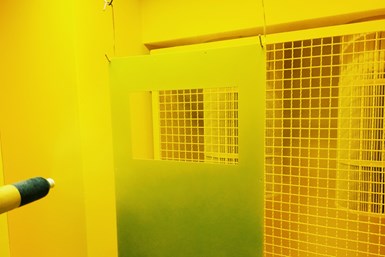Rework and Recoating Powder
Powder coating rework requires more than just recoating the part. Products Finishing columnist and powder coating consultant Rodger Talbert discusses proper steps that should be taken to ensure a quality finish.

Photo Credit: Getty Images
Q: We work hard to maintain a high percentage of good parts on the first pass, but we still have some parts with light coating or other minor defects that need to be repaired and/or recoated. We are not always successful at reworking these parts and now we have a second coat which can cause problems with orange peel and other issues. We need to know how to rework scratches or other surface imperfections in a powder coated finish and then successfully apply a second coat. Can you describe the process so that I can pass along a process for my operators for a reliable rework procedure?
A: There are several variables to this (the specific powder, nature of the defect, coating thickness, etc.), so I will provide a simple process that will cover the vast majority of rework.
- Remove all loose material by wire brush, sanding or similar mechanical abrasion
- Get a smooth surface in the rough areas using sandpaper or a grinder
- Blow off or wash off all remaining dust or particles
- Make sure the part is dry and free of all debris prior to coating
You will need to recoat the entire part with the powder spray so that none of the original coating shows through. If you do not get a complete and even second coat, you will have a dry spray look and uneven gloss. For optimum coverage, there are a few minor adjustments you should make to the guns. This is fairly simple with a manual gun. If you use automatic guns, it is best to batch up the rework and set a recipe for the adjustments.
- Reduce the amperage to around 20 to 40 micro-amps
- Increase the flow rate of the powder by about 10%
- Increase the gun-to-target distance about 1" to 2" farther than normal
- Maintain a constant gun-to-target distance
- Recoat the entire “A” surface
Cure the part for the normal cure cycle. Get your operators together for a brief training session on the proper technique to make sure they understand and can execute it. Practice on some scrap parts to perfect the technique.
One other thing that is good to know is that some powder materials are not great for inner-coat adhesion. They may need to be lightly sanded to achieve a good bond. You may need to do some testing to ensure the second coat will adhere.
About the Author

Rodger Talbert
Rodger Talbert began his career in coatings in 1976 when he went to work for a small company that does metal fabrication and custom coating. He worked there for 10 years, rising to the position of VP of Sales and Marketing. He left there to work as a sales engineer for a larger company that designs and builds coating systems, and worked there for seven years. In 1993, Talbert started his own business as a consultant. He ran his own corporation for 15 years before joining The Powder Coating Institute as technical director in 2009. He served as the PCI Executive Director until June 2012.
Related Content
Surface Preparation for Best Adhesion for Powder Coating
Kevin Biller with ChemQuest recommends the proper way to prepare a surface for powder coating that leads to excellent adhesion on 304SST.
Read MorePrevent Plating Problems with Critical Inspections
Tanks and their contents should be regularly inspected visually and analytically. When a quality issue arises, it is important to quickly pinpoint where the main problem is by checking which parameter is out of line.
Read MoreTroubleshooting Alkaline Zinc
One of the most common problems that can arise when plating with alkaline zinc is an imbalance of brightener in the solution. In this helpful Ask the Expert article, Chad Murphy of Columbia Chemical discusses how different zinc metal concentrations and brightener concentrations can impact efficiency.
Read MoreSurface Prep Solution for Rusted Rebar in Concrete
Julie Holmquist of Cortec Corporation discusses passivating corrosion on rebar and other reinforcing metals.
Read MoreRead Next
Proper Sieve Size for Powder Coating's Smooth Results
Kevin Biller at ChemQuest Powder Coating Research gives recommendations for sieve size to ensure surface smoothness.
Read MoreRecoating Best Practices
Powder coating consultant Rodger Talbert offers advice for recoating successfully without excess orange peel or inconsistent gloss.
Read MoreCauses for Cross Contamination
Cross contamination of powder coatings is often the result of poor habits in the powder room. Powder coating consultant Rodger Talbert offers an example of how to mitigate cross contamination.
Read More





















